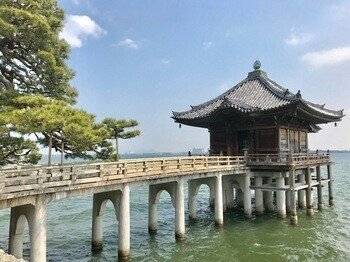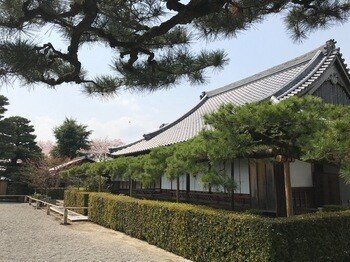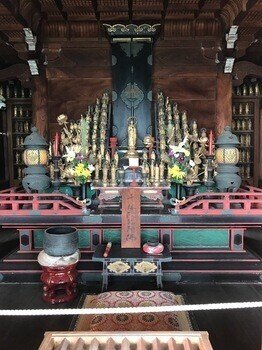
淡海の護り本尊「浮御堂」の風景 Scenery of "Ukimido", the principal image of the protection of the Biwa lake
この度は湖西を訪ねた。琵琶湖大橋を渡り堅田方面へ数キロ走ると湖上に建つ浮御堂が見えてくる。堅田地域の湖岸は、風光明媚なところとして人気の観光スポットである。
江戸時代に絵師、歌川広重の「堅田の落雁」が近江八景の一つとして描かれている。その画にあるように、湖上に突き出ている「浮御堂」が目をひく。ちなみに堅田の落雁とは、浮御堂付近の湖上に雁の群れが舞い降りる情景のことをいう。
This time I visited Kosei. After crossing the Biwako Bridge and running for a few kilometers in the direction of Katata, you will see the Ukimido that stands on the lake. The lakeshore of the Katada area is a popular tourist spot as a scenic spot.
Hiroshige Utagawa's "The Wild Geese Returning to Katada" is depicted as one of the eight views of Omi. As you can see in the picture, the "Ukimido" protruding above the lake is eye-catching. By the way, Katada's Rakugan is a scene where a flock of geese descends on a lake near Ukimido.


浮御堂は、平安時代に海門山満月寺の本堂として建立された。いまは湖畔に沈む夕陽をバックに写る浮御堂は幽玄の世界のように映る。
では、浮御堂がなぜ、この淡海の湖畔に建立されたのかを調べてみると、
日本の浄土教の祖と称される源信大師が比叡山横川から琵琶湖をながめていると、毎夜、その光明を怪しみ、網でこれをすくうと、1寸8分(5.5㎝弱)の黄金の阿弥陀仏像であった。新たな阿弥陀仏像を造り、その体内に光明輝く仏像を納めた。さらに1000体の阿弥陀仏像を造り奉安するために浮御堂を創建したという。
そして、湖畔に建つ浮御堂は「千仏閣」「千体仏堂」と称し、湖上通船の安全や魚類殺生供養するお堂として現在に至っている。
Ukimido was built in the Heian period as the main hall of Mangetsu-ji Temple on Kaimonsan Ukimido, which is now reflected in the background of the setting sun on the shore of the lake, looks like a mysterious world.
Then, when I investigated why Ukimido was erected on the shore of this lake, When Genshin Daishi, who is said to be the ancestor of the Jyodo-sect Buddhism in Japan, is looking at Lake Biwa from the Yokogawa on Mt Hiei. It was a Buddha statue. He created a new Amida Buddha statue and put a brilliant Buddha statue inside it. It is said that he built an additional 1000 Amida Buddha statues and built Ukimido to enshrine them.
The Ukimido, which stands on the shore of the lake, is called the "Senbutsukaku" and "Senbobutsu-do", and has been used as a memorial service for the safety of boats on the lake and for killing fish.

風景絶佳の趣のある地としてとどろき、古くより一休和尚、蓮如上人が滞在し、また松尾芭蕉や小林一茶、歌川広重、葛飾北斎等も訪れ、多くの詩歌、絵画を残している。
芭蕉は中秋の名月の翌日に詠んだとされる「鎖あけて 月さし入れよ 浮御堂」の句は、芭蕉が湖上舟から十六夜の月を賞し、浮御堂内の阿弥陀千体仏が月に輝く光景を想像して詠んでいる。また、阿波野青畝が詠んだ句「五月雨の 雨垂ばかり 浮御堂」は境内にある石碑に残され、五月雨に濡れた浮御堂の美しさを刻んでいる。
It roars as a quaint place with a magnificent landscape, and since ancient times Ikkyu osho and Rennyo Shonin have stayed there, and Matsuo Basho, Kobayashi Issa, Hiroshige Utagawa, Katsushika Hokusai, etc. have also visited and left many poems and paintings. Basho is said to have written the day after the harvest moon in mid-autumn. Imagine a scene in which a body Buddha shines on the moon. In addition, the phrase "May rain raindrops Ukimido" written by Seiho Awano is left on a stone monument in the precincts, engraving the beauty of Ukimido wet with May rain.

湖畔に浮かぶかのような御堂とその周辺の景観は淡海の財産である。歴史と文化に育まれ多くの人を魅了している浮御堂は現在、日本遺産に認定されている。
The scenery of Mido and its surroundings, which seems to float on the shore of a lake, is a property of lake. Ukimido, which is nurtured by history and culture and attracts many people, is now recognized as a Japanese heritage site.
※この記事は2018年4月「心と体のなごみブログ」に掲載されたものをリライトし転載。
レポート & 写真 / 渡邉雄二 写真 / ネットの堅田の落雁画像より転載Reported & Photos by Yuji Watanabe
よろしければサポートお願いします。日本の伝統文化に関心を寄せています。若いころに文化圏の異なる地域の方たちとの交流で日本のことをあまりにも知らなかったことに気づかされ、それがきっかけで広く浅く学んでいます。拙いレポートですが、お目に留めていただければ幸です。
